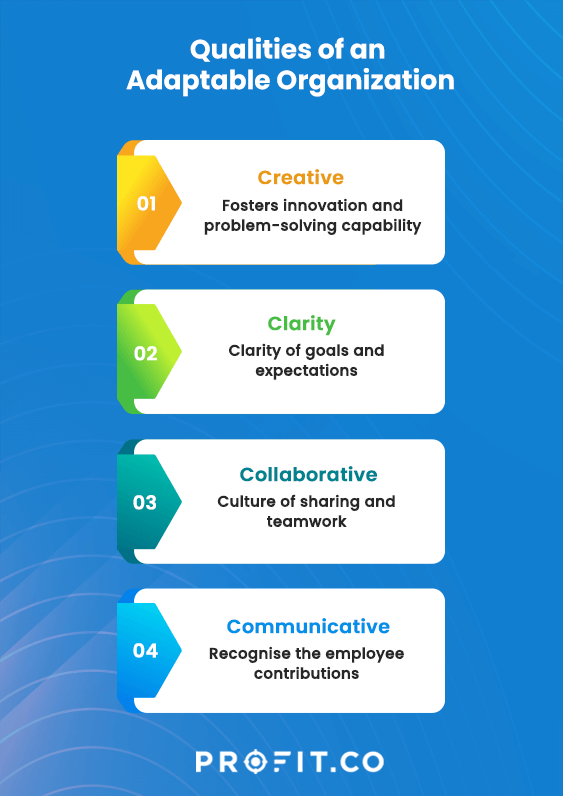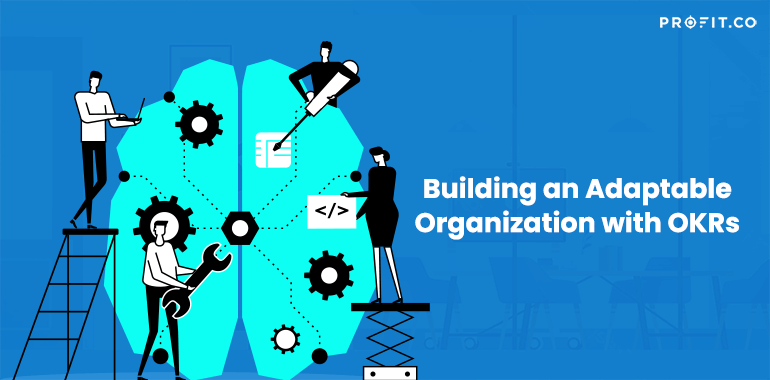Introduction
In today’s rapidly changing market, businesses must remain agile to survive and thrive. Otherwise, they quickly become outdated, inefficient, and unable to compete with faster-paced competitors.
A successful business needs the ability to pivot quickly and respond effectively to changes in the market or industry. Objectives and Key Results (OKRs) offer a robust framework to build such an agile organization.
Setting clear objectives and measurable vital results allows you to focus on the right priorities while monitoring your progress toward long-term goals.
This guide explores what is adaptability, why it’s important, the qualities of an adaptable company, and how you can leverage OKRs to build a culture of adaptability.
Why Should an Organization Be Adaptable?
Every business leader recognizes the necessity for their company to adapt for long-term viability. However, the true challenge lies in ingraining the ability to adapt and transform into the organization’s very fabric. The critical factor lies in attaining enduring adaptability. It involves developing a mechanism or instinct to effectively address a crisis, be it financial, technological, environmental, or health-related.
Many organizations rise up to a certain level of performance but Unfortunately, only about 17% retain that competitive edge for the next five years. This small percentage of businesses have discovered the importance of adapting to dynamic market conditions and reinventing their businesses.
Having an adaptable organization helps foster a culture of learning. You can benefit from new growth opportunities by adjusting your strategies and processes in response to changing market conditions.
Adaptability goes hand in hand with embracing new technology and innovation. Technology provides access to previously unavailable data points, helping you make informed decisions quickly and accurately when making changes.
Advanced analytics allow you to identify patterns within customer behavior so you can proactively anticipate trends rather than reactively respond when issues arise. If anything unexpected comes up, having clear goals in place makes it easier to adjust accordingly without sacrificing progress.
This system also encourages accountability amongst team members as they know exactly what needs to take place, when, and how much effort each task requires. Everyone can take responsibility for their contribution towards achieving shared objectives successfully.
For actionable OKRs get started with Profit.co
Qualities of an Adaptable Organization
Achieving and maintaining a competitive edge requires you to be willing and ready to accept change. This change can be in your concept, location, pricing, new services, or products, allowing you to anticipate when and how to change.
Adaptable organizations have several common traits, including
Creativity
Adaptable businesses nurture creativity among employees and adopt it as a business practice. Team members become more open-minded and accepting of new ideas. It would help if you had innovative approaches that lead into uncharted territory where growth opportunities exist.
Collaboration
Creating a positive culture fosters collaboration while inspiring creativity and innovation, which are crucial to adaptability and resilience.
It would help if you had innovative approaches that lead into uncharted territory where growth opportunities exist. Embedding OKRs into daily operations makes it easier for team members across departments to work together towards shared objectives and could help propel their business forward unexpectedly.
Clearly-defined workplace culture, goals, objectives, and expectations
Adaptable businesses recognize the essence of change and remain forward-thinking. Every team member understands integrating adaptability in all activities and business processes.
Setting clear goals means teams know what success looks like at every journey stage. It gives everyone clarity around expectations and motivates them to keep pushing forward until they achieve the desired results.Recognizing the value of employees
Adaptable organizations understand that employees are the key to finding innovative ways to seize new opportunities. Employees empowered with the right tools and training are more productive and provide a better customer experience.
This helps create a positive culture of adaptability that encourages employees to think outside the box when approaching solutions or taking on new challenges. It is advisable to balance autonomy and control to deliver the expected results. An OKR framework enables you to find this balance and clarify desired outcomes and goals.

How Does OKR Help Build a Culture of Adaptability?
One of the best adaptability examples within an organization is using objectives and key Results (OKRs) to manage resources. OKRs are a goal-setting and management framework that helps teams focus on the right priorities while tracking progress toward long-term goals.
OKRs foster alignment with measurable goals and key results to ensure everyone works to achieve objectives as quickly and efficiently as possible. They allow your business to maintain adaptability in the fast-paced market environment.
Communicating the benefits of OKRs throughout your organization is also essential for creating a culture of adaptability. All team members should understand why this system works, how it will benefit them individually, and how it contributes to the success of the business or project they’re working on.
Regular conversations around performance management will help keep things running smoothly while ensuring everyone has clarity over expectations and roles within their team or department. This kind of transparency encourages collaboration across departments which leads to better results.
FAQs
1. What are the benefits of using OKRs?
OKRs align the company goals with the team objectives. They keep team members motivated to attain the overall goals and encourage everyone to work harder, resulting in better performance and productivity. Tracking OKRs also ensures transparency and accountability.
2. Is there a difference between KPIs and OKRs?
One primary difference between KPIs and OKRs is that KPIs are achievable indicators that rate performance, while OKRs define the goals and change with time.
3. Can you have an OKR for immeasurable aspects?
While many objectives and key results (OKRs) can be measured, certain objectives may be difficult to measure or quantify. Some objectives may be focused on intangible outcomes, such as improving team collaboration or enhancing company culture, and these aspects can be challenging to measure with concrete metrics.
However, it is still possible to create key results for such objectives by identifying measurable indicators that reflect progress or activities related to the desired outcome. For example, for an objective focused on improving team collaboration, key results could include the following:
- Metrics like increased frequency of cross-functional meetings.
- Higher participation rates in collaborative projects.
- Improved feedback mechanisms.
It’s essential to balance measurable and immeasurable objectives to ensure a comprehensive approach to goal setting. While measurable objectives provide clearer visibility into progress, immeasurable objectives can capture critical qualitative aspects of organizational development.
Conclusion
Building an adaptable organization takes effort but is worth the investment as it sets your business up for success regardless of the changes that come your way. Embracing adaptability to remain competitive and resilient is the way to go.
Profit.co’s Intuitive dashboard helps you integrate OKRs into your business processes. It has advanced, robust tools that enable performance management, employee engagement, and task management so your team stays focused on the critical objectives.
It’s easier to track progress toward goals while holding everyone accountable for their contribution.



